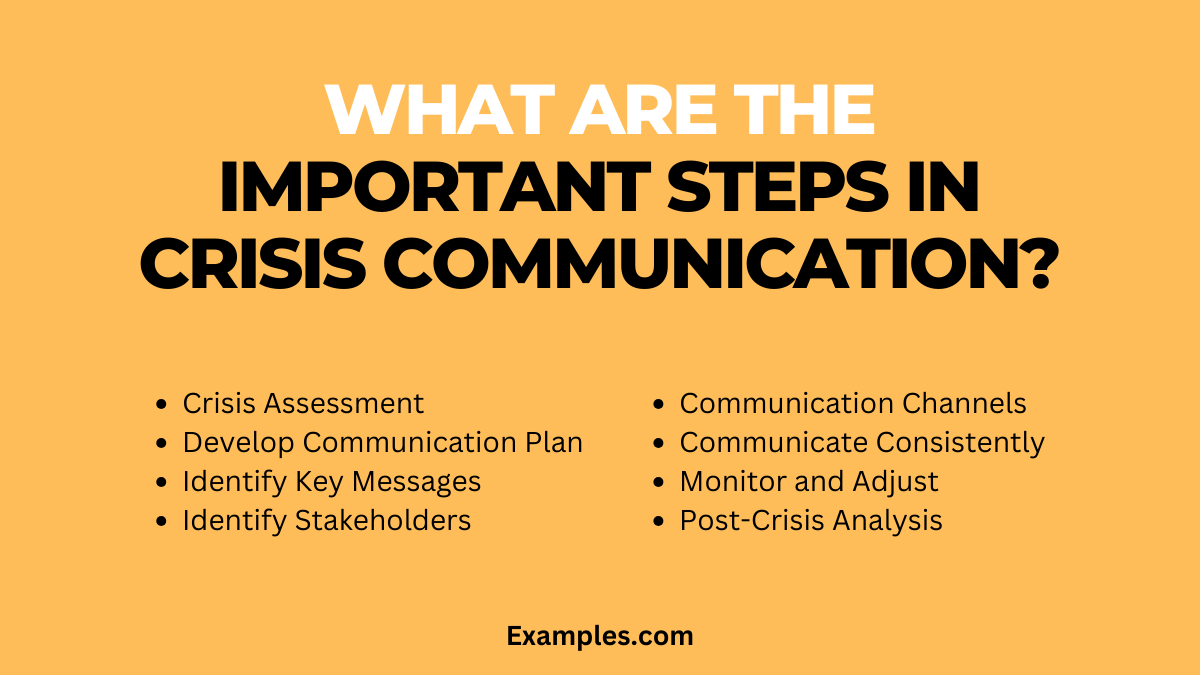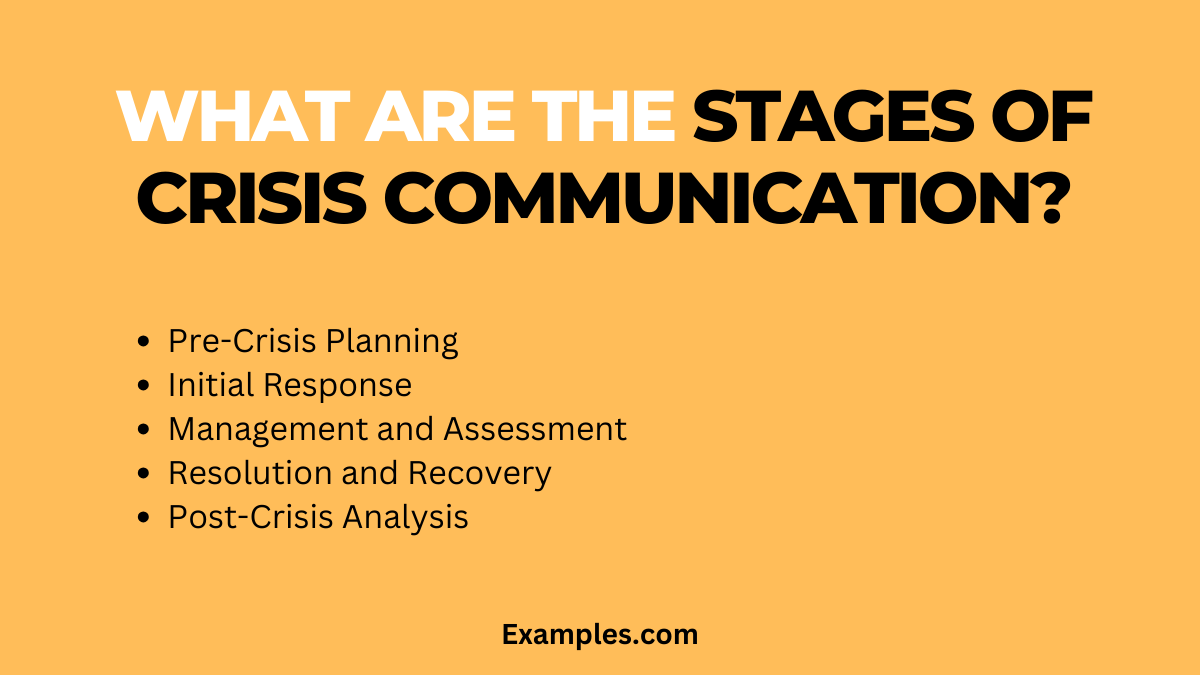Important Steps/ Stages in Crisis Communication
Crisis Communication is a pivotal aspect of organizational resilience and public relations. It involves the crucial steps of identifying, addressing, and resolving emergencies, especially in high-pressure situations. This guide delves into the definition, history, and origin of crisis communication, accompanied by practical examples. We also provide essential tips on effectively navigating these challenges. Whether it’s a corporate scandal, natural disaster, or public health crisis, understanding these key stages is vital for maintaining trust and clarity. Learn how to master the art of crisis communication with our comprehensive and insightful approach.
What are the Important Steps in Crisis Communication?

Important steps in crisis communication involve a series of strategic actions crucial for managing a crisis effectively. Firstly, immediate assessment of the situation is essential to understand the scope and impact. Developing a communication plan that addresses various stakeholders is the next step, followed by rapid response to mitigate misinformation and panic. Clear and consistent messaging is critical, ensuring that the information shared is accurate and uniform across all channels. Engaging with stakeholders, including employees, customers, and the media, is a key element, providing regular updates and being transparent. Monitoring and adapting strategies based on the evolving situation is another vital step, allowing for flexibility in response. Finally, post-crisis evaluation to learn from the experience and improve future crisis communication strategies is essential. Each step requires careful consideration and execution to effectively manage and resolve the crisis.
- Crisis Assessment: Quickly evaluate the situation to gauge its severity and potential impact. This helps in determining the scale and type of response needed.
- Develop a Communication Plan: Formulate a plan that details communication strategies, including messaging, target audiences, and timelines.
- Identify Key Messages: Determine the crucial points that need to be communicated. These messages should be clear, concise, and relevant to the situation.
- Identify Stakeholders: Acknowledge all groups impacted by the crisis and understand their specific needs and concerns.
- Select Communication Channels: Choose the most effective and appropriate channels to reach your stakeholders, such as social media, press releases, or internal communication networks.
- Communicate Early and Consistently: Provide initial information swiftly to manage perceptions and follow up with regular updates as the situation evolves.
- Monitor and Adjust: Continuously monitor the effectiveness of your communication and the evolving situation, adjusting your strategy as necessary.
- Post-Crisis Analysis: After the crisis, review your communication efforts to identify strengths, weaknesses, and areas for improvement.
What are the Stages of Crisis Communication?

The Stages of Crisis Communication are vital steps organizations must take to manage crises effectively. Initially, Preparation and Planning is key, where strategies and protocols are developed before a crisis occurs. Next is the Identification and Analysis stage, where the crisis is recognized and its potential impact assessed. Response follows, where communication strategies are implemented to address the crisis publicly. Resolution and Recovery involve steps to resolve the crisis and mitigate its effects. Lastly, Post-Crisis Analysis is crucial for learning from the incident and improving future crisis communication plans. These stages ensure a systematic and effective approach to handling crises.
- Pre-Crisis Planning: Involves developing a comprehensive crisis management plan that addresses potential risks and outlines strategies for communication.
- Initial Response: This critical phase is the first point of communication when a crisis emerges, where immediate, clear, and concise information is vital to set the tone for managing the situation.
- Management and Assessment: During this stage, the focus is on ongoing communication while managing and continually assessing the evolving crisis situation.
- Resolution and Recovery: This phase involves communicating the steps towards resolving the crisis, focusing on recovery efforts, and reassurance about future prevention.
- Post-Crisis Analysis: The final stage entails a thorough review of the crisis and the effectiveness of the communication strategies employed, learning from experiences to refine future approaches.
What are the Phases of Crisis Communication?
Here are the phases of crisis communication:
- Preparation and Prevention: This involves creating a crisis management plan and training teams. Proactively developing strategies and protocols can significantly reduce the impact of a crisis.
- Identification and Assessment: Recognize when a crisis is occurring and assess its potential impact. Quick identification and accurate assessment are crucial for an effective response.
- Response and Management: This stage is about effectively communicating during the crisis. It involves disseminating clear, accurate information and managing the situation as it evolves.
- Resolution and Recovery: Focus on resolving the crisis and communicating the steps taken for recovery. This stage is also about reassuring stakeholders and beginning the process of rebuilding.
- Learning and Adapting: After the crisis, it’s important to analyze what happened and how it was handled. This helps in improving future crisis response strategies.
What are the Steps to Create Crisis Communication Plan?
Here are the steps for preparing crisis communication plan:
- Risk Assessment: This involves identifying and evaluating potential crises that could impact the organization. Understanding these risks helps in tailoring the crisis communication plan.
- Team Formation: Assemble a dedicated crisis communication team. This team should comprise members with diverse skills, including decision-making, communication, and technical expertise.
- Communication Strategy: Develop a clear strategy that outlines how to communicate during different types of crises. This includes protocols for internal and external communication.
- Resource Allocation: Allocate necessary resources, including technology and personnel, to ensure effective communication during a crisis.
- Training and Drills: Conduct regular training sessions for the crisis communication team. Drills and simulations help in preparing the team for actual crisis scenarios.
- Review and Update: Continuously review and update the crisis communication plan to ensure it remains effective and relevant to current risks and scenarios.
How to Navigate the Stages of Crisis Communication?
Crisis communication is a crucial skill for any organization. Navigating the stages of crisis communication effectively can make the difference between reputation damage and successful crisis management. Here are the steps to guide you through this process:
Step 1: Identify Potential Crises
The first step in navigating crisis communication is to identify potential crises. Conduct a thorough risk assessment to pinpoint scenarios that could harm your organization’s reputation. This involves considering internal and external factors that may lead to crises.
Step 2: Develop a Crisis Communication Team
Assemble a crisis communication team comprising key personnel from various departments. Assign specific roles and responsibilities, including a spokesperson, media contact, and social media manager. Ensure everyone is well-trained in crisis communication protocols.
Step 3: Create a Crisis Communication Plan
Create a crisis communication plan that outlines the procedures to follow during a crisis. This plan should include protocols for gathering information, assessing the situation, and activating the crisis communication team. It should also detail communication channels, both internal and external.
Step 4: Establish Communication Protocols
Establish clear communication protocols. Determine how and when information will be shared with stakeholders, employees, the media, and the public. Ensure consistency in messaging and designate official communication channels.
Step 5: Monitor and Evaluate
Monitor and evaluate potential crises in real-time. Implement robust monitoring tools to stay aware of any emerging issues. Regularly assess your crisis communication plan and make necessary updates to keep it relevant.
How to Implement the Steps for Preparing Crisis Communication?
Effective crisis communication begins with thorough preparation. Implementing the steps in preparing crisis communication ensures your organization is ready to respond when a crisis strikes. Here’s how to do it:
Step 1: Assess Your Organization’s Vulnerabilities
Begin by assessing your organization’s vulnerabilities. Identify weak points, potential risks, and areas where crises might originate. Consider both internal and external factors that could impact your organization.
Step 2: Develop a Crisis Communication Strategy
Develop a crisis communication strategy tailored to your organization’s specific needs. This includes defining your target audience, key messages, and communication channels. Ensure your strategy aligns with your organization’s values and goals.
Step 3: Create Pre-Approved Messaging
Create pre-approved messaging templates for various crisis scenarios. These templates should include general statements, key information, and a tone that reflects your organization’s values. Pre-approval saves valuable time when responding to crises.
Step 4: Conduct Crisis Simulation Exercises
Regularly conduct crisis simulation exercises to test your team’s readiness. Simulate different crisis scenarios and evaluate your team’s response. Use these exercises to identify areas for improvement in your crisis communication plan.
Step 5: Provide Training and Education
Provide training and education to your crisis communication team and employees. Ensure they understand their roles and responsibilities in a crisis. Train them on communication protocols, media interactions, and social media management.
Step 6: Establish Communication Protocols
Establish clear communication protocols for different crisis scenarios. Define the chain of command, designate spokespersons, and specify who has the authority to approve messages. Ensure these protocols are documented and accessible to the crisis communication team.
Step 7: Regularly Update Your Plan
Finally, regularly update your crisis communication plan. As your organization evolves, so do potential crisis scenarios. Stay current with industry trends and adjust your plan accordingly to remain effective in managing crises.
In conclusion, Important Steps/Stages in Crisis Communication encompass a comprehensive approach vital for any organization. From initial preparation to post-crisis analysis, each stage plays a critical role in managing a crisis effectively. Emphasizing clear, transparent communication and stakeholder engagement, these stages guide organizations to not only navigate through crises but also learn and evolve from them. Implementing these steps can significantly improve an organization’s resilience and response to future challenges.



